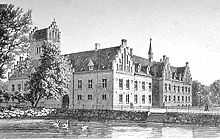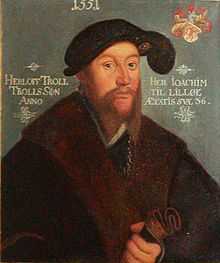Herlufsholm School
| Herlufsholm School and Estate | |
|---|---|
| Herlufsholm Skole og Gods | |
| Established | 1565 |
| Type | Private School |
| Chairman | Jens Moberg |
| Headmaster | Klaus E. Jakobsen |
| Founder | Herluf Trolle & Birgitte Gøye |
| Students | 600 (approx.) |
| Grades | 6th to 12th |
| Location |
Herlufsholm Kostskole, Næstved, Denmark |
| Colors |
Blue and white (Gøye family) Yellow and red (Trolle family) |
| Yearbook | Diple og Hørere |
| Newspaper | Kontakt |
| Website | www.herlufsholm.dk |
 | |
Herlufsholm School and Estate (Danish: Herlufsholm Skole og Gods) is a private day and boarding school for boys and girls (co-educational since the 1950s), founded in 1565 by Admiral Herluf Trolle and his wife Birgitte Gøye.
The school is located by the Suså river in Næstved, about 80 kilometers south of Copenhagen, capital of Denmark. As the oldest boarding school in Denmark, the school hosts a number of unique traditions. Trolle-morgen (at which Herlovians commemorate the birthday of the founder Herluf Trolle) and Fugleskydning ("bird-shooting"), when old and new students visit the school with their families, are the two biggest events of the year.
Herlufsholm offers a range of educations from 6th grade in the Danish lower-secondary school, the optional 10th grade, continuing with 1st - 3rd grade of upper-secondary school, called STX. The international programs include a preparatory class (1-2 year) with IGCSE exams and the international baccalaureate, IB. The school has more than 600 students, approximately 275 students are boarders.
Today it is the only school in Denmark with a compulsory school uniform[citation needed], and has approximately 600 students. The number of boarding students is roughly equal to day students. Although the majority of boarders come from Denmark, a fair share come from abroad, particularly those studying for the IB diploma.
In 2012 the school launched a summer school for children interested in Denmark or with Danish ancestors.
History
The founding of the school
Herlufsholm School was originally erected as a Benedictine monastery, founded in 1135.
During the second part of the 12th century the church and monastery was built, and is preserved today by the school and used daily by the students and staff. It is generally believed that the monastery originally was called Næstved Sct. Peder’s Monastery but during the years the name changed to Skovkloster (loosely translated into “The monastery by the forest) due to its location just outside the city of Næstved in the forests by the river Suså.
During the Reformation in Denmark, the Danish King Christian II seized all Catholic episcopal property, including Skovkloster. The king let the monks stay but the last monk left the monastery anyway in 1559 in favor of another monastery in the city Sorø not far from Næstved.
The Danish naval officer and hero Herluf Trolle and his wife Birgitte Gøye took possession of the monastery in 1560 by trading in their home Hillerødsholm (which later was renamed Frederiksborg). The couple renamed the monastery Herlufsholm and founded the school in 1565 as a shared dream. However, one of the founders was never able to see his dream unfold. Herluf Trolle was wounded fatally during the Great Nordic Seven Years' War and never recovered. He died in Copenhagen in June 1565.
Newer history
Herlufsholm School started as a boarding school only for boys. In 1966 the school opened for day students allowing the children from the local area to take an education without applying as boarding students. This also meant that the school had an increase in the number of applicants. 1966 was also the year the school opened up for both genders. Girls were allowed as day students. In 1985 the school erected a dormitory for female boarders, allowing both genders to apply as boarding students.
School founders
-

Herluf Trolle (1551), Collections of Frederiksborg castle
-

Birgitte Gøye (1550), Frederiksborg collections
-
Herluf Trolle and Birgitte Gøye carved in wood
The school has been co-educational since 1985 - not since the fifties.[citation needed]
The Herlufsholm Summerschool
In 2012 Herlufsholm School began offering children aged 12–15 the chance of experiencing Denmark for two weeks at the school. The summerschool is a smaller initiative, only accepting around 30-40 participants and focusing on Danish lessons, sports, arts and social activities.
School Buildings

The second largest building is Skolebygningen ("The School Building") which contains two dormitories and some classrooms. Up until the middle of the 20th century most of the teaching took place here, but now less than half the school's classrooms are located here.
The third most important building is Museumsbygningen ("The Museum Building"), which contains another two dormitories, the science department, the biology department and the school's collection of historical scientific apparatus and specimens of animal species, many now endangered; the collection dates from the 1870s.
Herlufsholm also has a separate library (one of the oldest in Denmark), a small hospital, the principal's house, a few house for teachers and various other service and administrative buildings.
The rest of the classrooms are located in Gymnasiefløjen where the teaching of the Gymnasium classes (the Danish high school)takes place. The Gymnasie Building is connected to the principal's office, the staffroom and Helenhallen, which is the second largest gym, also containing a stage.
Recently the school erected a new modern gym in order to accommodate the growing number of students, named Trollehallen after the founder.
The school's other dormitories are: Skolebygningen (Skygningen); Museumsbygningen (Mygningen); Vuggestuen (Vuen); Egmontgården; Lassengården; Birgitte Gøye-gården; and Pernille Gøye-gården. The newest dormitory Bodil-gården finished construction in 2010, and is thereby the second mixed-gender dormitory along with Lassengården
Notable Alumni (Gammelherlovianere)
- Anders Lassen (Major, recipient of the Victoria Cross)
- Bernt Johan Collet (Danish Minister of Defence)
- Christian Albrecht Bluhme (Prime Minister of Denmark)
- Christian Stadil (Owner of Hummel International)
- Corfitz Ulfeld (Statesman)
- Jákup Jakobsen (Linguist)
- Jens Fink-Jensen (Photographer)
- Joachim Gersdorff (Politician)
- Johan Philip Asbæk (Actor)
- Knud Sehested (Minister for Agriculture)
- Kristian von Hornsleth (Artist)
- Niels Ryberg Finsen (Physician)
School spirit
The school has continually been home to students since its foundation. Possibly because of its origin as a monastery, the pupils are called disciples. Students are also called Herlovianere (Herlovians), and former students are Gammelherlovianere (Old Herlovians). Until recently the school was an all-boys boarding school, but to meet the standards of the new century the school gradually opened for day students and girls. In the 1990s the board implemented the International Baccalaureate. Herlufsholm is the only school in Denmark with a compulsory uniform.
The Uniform
The uniform is centered on the blue shirt with Birgitte Gøyes crest on the chest which every student 6th-12th grade, boarding as daystudent must wear at school - except at gym class of course. Generally students wear charcoal-grey or blue pants - light color variations are banned and so is black. Students in 12th may wear white pants - supposedly a reference to the navy. Over the shirt students often wear a pullover in either grey or blue. All students are opt to buy the two school ties - which they are only obliged to wear when wearing their blazer. Students in middleschool, 6th-9th, may wear a double-buttoned blazer, students in the preparatory class (between 9th and 10th grade) as well as the students in 10th-12th grade may wear the school blazer with the Gøye arms on the chest. Prefects wear the Trolle arms instead.
Herlovianersproget
A unique thing about the school is that the students have their own mini-language called the herlovianersprog. Words are obtained by simply taking the first and last syllables of a word and making a portmanteau of the two. So for instance, skolebygning ("school building") becomes skygning. Only imagination limits the possible words. Even though the language is exclusively utilized by the students some words have been adapted into Danish, for instance "svælling" (cygnet), which there was not previously a specific word for in Danish, is herlovian for Svane + Ælling (Swan + duckling). So far two dictionaries have been published.
Traditions
Herlufsholm has a long list of traditions. The two biggest events of the year are:
Trolle-morgen
Trolle-morgen January 14, the founder's birthday, is a major event, as many old students return to the school on that day to commemorate their founding father in the dark hour of early morning.
Fugleskydning
Fugleskydning ("bird-shooting") in mid-August starts the new school year. It is a tradition dating back to the latter part of the 19th century. Old and new students meet at the school to shoot down a wooden bird on a pole with bows and arrows.
Students march out of the old school building, Skygningen, to the front of the principal's house where he gives the big wooden bird to 3G, and the little wooden bird to the 9th graders. The procession then continues around the Klosterbygning where the Forstander (provost) cries out a hurray for the "fugleskydning". The procession then continues into Nyhave ("New Garden") where a square is formed and the Fugleskydning song is sung, accentuated by firecrackers simulating cannon fire.
References
- ↑ known in the school slang as vuen, a portmanteau of vuggestuen, "The kindergarten". When the dormitory moved into its own building the name followed and the formal name of the dormitory for the youngest boy students is still Vuen
External links
Coordinates: 55°14′45″N 11°44′55″E / 55.24583°N 11.74861°E
